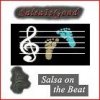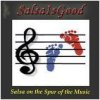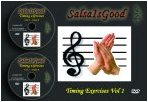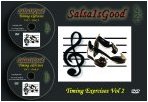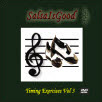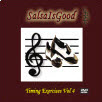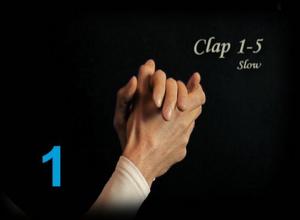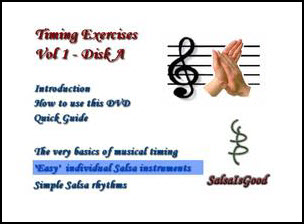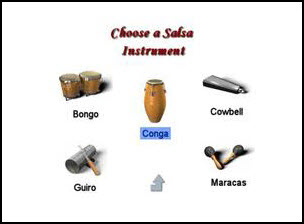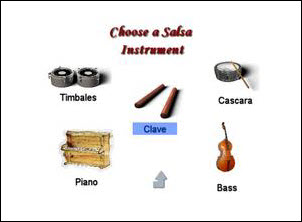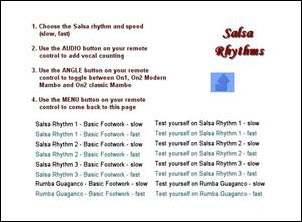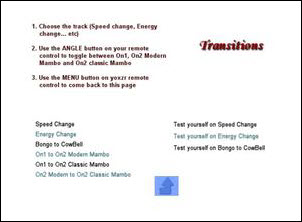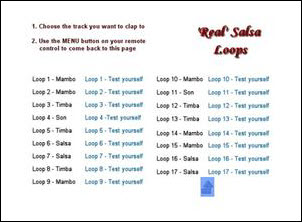| |
Timing Exercises Vol 1 & 2
|
| 4 DVDs - $80 $70 |
|
|
 |
|
 |
|
This program will help you solve your timing problems once and for all. It is specifically designed for people who like to learn by doing, who lack confidence on the dance floor despite an extensive repertoire, who struggle to find the beat when anything but simple salsa music plays or who may find it difficult when the timing of a song changes halfway through.
|
 |
|
"My prayers were answered when I found these salsa timing DVDs. I was ready to just give up. That all changed when the "Salsa Timing Gods" appeared in the form of www.salsaisgood.com in my google search. I ordered the first DVDs and the CD and it was like having a compassionate doctor fianlly diagnose your disease. I had the "I can't hear the beat" syndrome and they took all the shame away and told me I would have to learn a different way if I simply followed the prescribed exercises.
These products will teach you how to dance on beat in the privacy of your own home so that when you go to class it will all make sense to you and you can use that class time to enjoy yourself instead of in a secret panic because you know your off beat. These products understand the timing problem most people have and they have figured out a way to really teach salsa timing. I am going to say this! If you practice with these DVDs you can learn! I did!
I can never stop talking about these DVDs to my fellow dancers no matter how advanced. INSTRUCTORS. If you have beginners that you know are having a hard time with the beat be merciful and recommend this site to them.
" (Jacqueline, jcqlnprz at yahoo . com)
"Yes, I loved your DVDs. I've been dancing for years trying to improve, taking classes, practicing a lot, and having a lot of problems (I guess I'm not that talented a dancer!). But your DVDs on rhythms was a real eye opener - I never even knew that rhythm existed. After just one week my dance improved so much that people noticed. You did a great job on that one (at least for me)." (Margaret, margaret ahmad at hotmail dotcom)
"Another excellent and fantastic set of discs from the
masters of tution! Once again easy to follow well presented by the
team at Salsa is Good, quality teachers are rare to find and this set
compliments and aids, the beginner or even the advance dancer to
perfect their dancing" (Robin, envirogen at yahoo.co.uk)
"It's almost two months since I started training with the Salsa Timing exercises DVDs..... These Salsa Is Good DVDs are more than fantastic, they are unique. They include all the information I couldn't find anywhere else (I searched quite a while). Precious data that help me to progress very quickly alone, at my own pace whenever I want. In my opinion rhythm is the main first element for dancing. I had a 'serious' problem with rhythm, thanks to these DVDs, I don't have it anymore. Of course a serious practice is required to get the full benefit of these DVDs. An advice: don't spend hours the first week you receive the DVD and never again after. Just put the DVD on every time you feel like it. Through time, the exercises which didn't seem interesting the first week will become interesting and bring you their benefits." (Art, artsski_at_yahoo.com)
"(these DVDS) are indispensable. I am using them both for my own personal training and for the courses I teach here at the University of California on the socio-cultural history and meaning of Afro-Caribbean music (and dance)" (William I. Robinson
Professor of Sociology and
Global and International Studies
University of California-Santa Barbara
, w.i.robinson1 at_gmail com)
"I got the DVDs and their great. I must admit even before buying the DVD's I had no problem dancing on time, however I was looking for a deeper understanding of salsa music. These DVD's have helped me a lot in in this matter. They are without a doubt the ultimate timing instructional DVD's. Thank you very much and I would like to know when your new DVD's come out." (romanrounkle at hotmail.com)
"I am very impressed by what you have done and how you have matched the need of people like me. I was ashamed of what I thought being a misunderstanding of the rhythm and a non feeling of the music.
...
Now that I know what the music instruments are in salsa, when they occur in the bars of music as it is said, I can search for them in the songs, and then of course everything is more simple. Most of the time now I catch the rhythm or at least the bars thanks to the congas, the montuno or some percussions (I am not always sure of what they are, but I am sure to be in the beat. Incredible, what a satisfaction and a pleasure to touch the ground with your foot, when an instrument beats in the same time. I enjoy also particulary brass instruments, and sometimes I can hear them beginning on the “1”, incredible!
I am still in a learning phase, but I have the feeling that I have progressed so much.
Yesterday night, I did my first steps on the weak beats of the music, on a real song: I thought it was impossible for me.
I have so much things to learn, but with your DVDs, I would say: YES I CAN!
Thanks and congratulations.
"
(Francois, francois dot @ alcatel - lucent dot com)
"Rarely do I introduce a new SALSA-DVDS.COM product to you in this column, but this time I want to make an exception for this particular package that will cause a revolution in the way you approach your dancing.
Austrialian based SalsaIsGood has produced a Timing Excercises Package of 2x2 DVDs that will not only show you everything there is to know about rhythm and timing, but let you experience it as well!
Let me show you why you NEED to buy this package with some simply Q&A...:
" (Annetje, SALSA-DVDS.COM)
"They are indispensable. I am using them both for my own personal training and for the courses I teach here at the University of California on the socio-cultural history and meaning of Afro-Caribbean music (and dance)" (Bill, w.i.robinson1 at_gmail dot_com)
|
| ....and click here to read more testimonials! |
Main Features: |
•This timing DVD series is completely different from all others. It is not something to watch, it is something to exercise with.
•It will help you
to get in the groove, feel the music and dance with anybody, both on1 AND on2!
• Exercise with literally endless repetition and no need to rewind since the
clips loop forever
• Use the tests along the way to monitor your progress
• Start with clapping exercises in Vol 1 till you perfect your timing
in a variety of situations
• Practice with real salsa instruments, real salsa songs and your choice
of speed to be ready for every new salsa on the dance floor
• Advance to footwork exercises in Volume 2 with different styles of
salsa music as well as individual salsa instruments till you get it right
• Choose which exercise to practise, whether you want a visual or
vocal guide and whether you want to dance on1 or on2, then pass the
tests!
|
|
|
|
|
|
|
Timing Exercises
Description
|
The symptoms may vary but they follow an unmistakable pattern: you have danced for months, maybe years. You know lots of turn patterns, shines and styling tricks, but you and the music are still two separate entities. People talk about feeling the rhythm, catching the ‘two’ and getting into the groove and you have no idea what they are talking about. It’s a common disease in salsa. It’s called ‘ can’t hear the beat’
You have tried every drug available over the counter, rhythm CDs from different schools and many group and private classes. Things improved a little, but the signs of the disease are still there.
You need a stronger drug, a diagnosis and a new plan. This is where SalsaisGood becomes your personal trainer, with a progressive exercise plan to get you on the road to salsa health. The fun starts as you finally feel and look good on the dance floor. How does it work? Easy! You do the rhythm exercises with a music assistant who dances with you, guides you and checks your progress for as long as you want without getting tired. You can now practise with our rhythm exercises anytime and for as long as you wish.
This DVD series complements timing CDs by including tools that deal with two important gaps in the way dance is taught, that are crucial to improve your timing.
Firstly, salsa beginners usually want to learn to dance and not to learn music! Still, music is the soul of dancing and salsa music is rhythmically complex. We lead you through some of the exercises young children are taught when they first start music classes. Volume One focuses on learning to clap to the music in time, distinguishing the strong beats, the syncopated beats and their combinations, which is crucial to dancing On1 or On2
Once you learn this you will move that understanding from the hands to the feet. In Volume Two you will learn to perform basic salsa footwork using the very same rhythms you previously learned in Volume One, plus more.
Secondly, you will learn by having the opportunity to exercise with literally endless repetition and no need for vocal explanation. Your private tutor will guide you through the exercises with no need to rewind since the clips loop forever. You choose which exercise to practise and which guide you want the tutor to provide. It can be a visual guide, by following the tutor executing the basic steps or clapping, or by following the beat counter on the screen. Or it can be a vocal guide, by counting the beat for you. We catered for plenty of different learning styles!
According to your progress you can reduce the amount of guidance your tutor provides, until you are ready to test yourself via a set of clips designed to see if you have learned to execute the exercises correctly. You don’t want to make a fool of yourself on the dance floor, right? This tool is important and cannot be found in other dance DVDs. Once you pass the test you can progress to the next exercise. If you don’t pass first time, don’t panic, the tutor never tires and you can keep doing the exercise until you are ready to pass the test. Everyone can learn this way. You don’t even need a partner!
Music-wise, there is as much variety as it was possible to fit into the DVDs and enough challenges both for the uninitiated and the experts. On top of the customary clave, conga, piano and guiro rhythms, you will find all percussive instruments which make up a salsa band, including timbales, cascara and maracas. Each instrument plays up to 4 different variations and some are very challenging. There are 3 different salsa rhythms with full instrumentation and, most importantly, loops taken from ‘real’ salsa music, the ones you might encounter on the dance floor. These include traditional salsa, Cuban son, timba, rumba Guaguagnco and old school mambo. For each of these rhythms you will get continual feedback on your progress which you can test, in order to guarantee a deep understanding. Most importantly, you will focus on rhythm transitions, from slow to fast, from simple to complex and between different rhythms. You will soon feel at ease with rhythm changes so that when this happens during a salsa song you won’t be caught out! This is something our customers specifically requested!!
Finally! The cherry on the cake!! All footwork is showed On1 and On2 with exercises so you can learn the difference and so you can transition between them at ease. If you learn this you will be able to dance with anyone from anywhere. You will finally become salsa multilingual..
| 4 DVDs - $80 $70 |
|
|
 |
|
 |
|
|
How to use Timing Exercises Volume 1
|
| This DVD series is organized very differently from other dance DVDs. So it is very important you spend a few minutes reading these instructions carefully to make the most of it.
What is in the DVD? This DVD is not for passive entertainment. This DVD is a timing program with exercises for you to do and exams along the way. Doing the exercises involves clapping your hands in time to the music with different instruments, different speeds and increasing levels of difficulty! You can work your way through the program by selecting each of the different clapping exercises, one by one, and then performing them by following the DVD. You can test your progress by checking your clapping against what you see and hear in the DVD and by selecting the “test yourself” clips when you are ready. At all stages, you need to actively participate to get the most out of the DVDs.
What do I need to know? To use this DVD series you need no knowledge of salsa dancing because you are only clapping in order to learn the timing. It may help to have some knowledge of musical timing, some of which is explained in our DVD ‘Salsa on the Spur of the Music’. Knowledge of musical timing will help you to make more sense of some clapping exercises, but it is not necessary in order to perform them. Some people learn better with some theoretical knowledge, if you are one such person, have a look at the DVD ‘Salsa on the Spur of the Music’; if you learn better ‘by doing’ just proceed to the clapping exercises.
How do I use the DVDs? These DVDs are for active learning and take commitment. They include a choice of more than 90 individual clips and each clip is a separate clapping exercise. Each clip loops forever, that is, it repeats continuously without stopping so that you never need to rewind. It is designed this way so that you can do each exercise for as long as you need. When you are happy with your progress and you want to change exercise, press the Menu button on your Remote Control. This will stop the clip and bring you to the DVD menu, where you can choose the next clapping exercise.
How should I proceed through the DVDs? Now, let’s see how the DVD series is organised.
|
Instructions for Disc A (Volume 1) |
Disk A. When you first start Disk A you will see a menu like the one in Figure 1.
1) Select the title The very basics of musical timing, with your remote control and press Play. This Chapter contains a basic ‘non-salsa’ rhythm in 4 beats. This may sound to you like most ‘western’ rhythms you hear on the radio. The very first thing you need to do is to be able to clap to those 4 beats steadily.
|
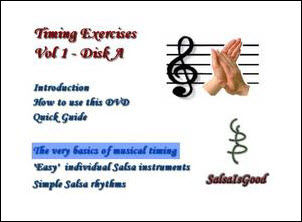
Figure 1. |
|
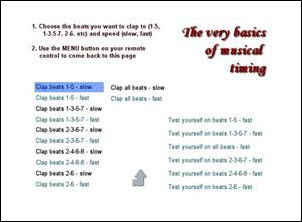 |
|
The second thing is to recognise which is the first beat, which the second etc. . This is what these clapping exercises are designed for. The menu for this chapter is shown in Figure 2. You can choose which beats you want to clap to (1-5, 2-3-6-7, etc) and the speed (slow or fast) by selecting one of the titles on the left hand side of the screen and pressing Play. A clip will start to play showing the hands clapping to the chosen beats, as in Figure 3. Try to follow the hands and synchronise your clapping to the rhythm.
Notice the beat counter on the bottom left: it shows all the 8 beats of a typical music phrase, with the beats you have to clap to highlighted in blue. Remember, the clip loops forever, that is, it never stops so you can practise your clapping until you are satisfied with your progress. To stop the clip, press the Menu button on your remote control. The ability to clap to the correct rhythm of the music is necessary whether or not you dance salsa: it is universal to all kinds of social dancing. |
| Figure 2 |
|
Some people have an instinctive, unconscious understanding of music; if you are one of those people, you will probably simply need to scan through these exercises once. If you are not one of those people, we suggest you stick to these clapping exercises until you master them. Check your progress against the set of clips called Test yourself on beat… in which the clapping guide on the video comes and goes.
When the guide disappears, keep on clapping to the music following your internal clock. Once the guide comes up again, check that you are in synch with it. If you consistently find yourself in synch, then you can progress to the next chapter; if not, keep doing the exercises. In salsa music finding the beat will be harder so if you do not succeed in this basic rhythm it will be much more difficult in the more complex salsa rhythms. |
|
Figure 3 |
|
|
|
2) Once you have mastered the previous chapter (but only then!) proceed to chapter Easy individual Salsa instruments (from the main menu as in Figure 4).
Once you choose this chapter you will see a menu as in Figure 5. This section contains the basic rhythm that some salsa instruments play in common salsa. These are the ‘easy’ rhythms, as in the ones that are easier to follow and easier in which to recognise the beat. Once again, explanation of the role of these instruments in salsa music can be found in our DVD Salsa on the Spur of the Music. |
|
| Figure 4 |
|
| |
Choose any instrument by highlighting its icon and pressing Play on the remote control. For example, choose the Clave, as in Figure 5
3) As for the previous chapter The very basics of musical timing, here you will see a set of clapping exercises: the exercises allow you to practise clapping to the different beats of the music: beat 1 and 5 (1-5), beats 1,3,5 and 7 (1,3,5,7) etc. Each of the clapping exercises comes at two speeds, slow and fast. Choose an exercise, for example Clap beats 1-5 to Conga - slow. You will see a video clip of the hands clapping beats 1 and 5. Practise along in order to learn to recognise those beats.
4) Each instrument in salsa may play a different rhythm, to give variety to the music. By using the Audio button on your DVD remote control you can toggle between different rhythms. Try to press the Audio button and you will see you can choose among 4 different Conga rhythms (other instruments may have 2 or 3 different rhythms). You can challenge yourself by learning to follow different rhythms for each instrument, so that not only do you learn to listen to different subtleties in the music, but also so that you never get bored!
|
|
| Figure 5 |
|
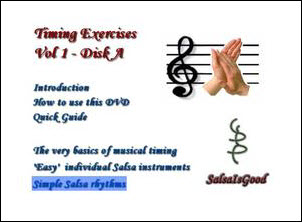 |
|
5) Once you have mastered the Conga rhythm, try the other ‘easy’ salsa instruments: Bongo, Guiro, Maracas and Cowbell.
6) Once you have understood the basic rhythm of these instruments, proceed to the chapter Simple Salsa Rhythms (from the main Menu, as in Figure 6). Here, you will find a menu similar to the one we described for the Conga. Choose which beat you want to exercise with and then choose the speed. With the Audio button of the remote control you can toggle between 3 different salsa songs; here is where you can check how to bring your understanding of the salsa rhythm to a full song with basic instrumentation, including a piano and a bass.
|
| Figure 6 |
7) Once all this is under control, (but only then!) you can progress to Disk B.
Instructions for Disc B (Volume 1)
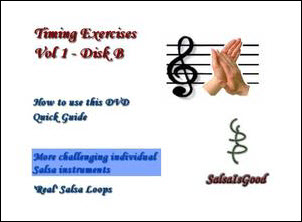 |
|
As you may expect it contains more challenging rhythms. Choose the chapter More challenging individual Salsa instruments, as in Figure 7. Here you find the most challenging salsa instruments: piano, bass, timbales, cascara and clave, as you can see in the Menu in Figure 8. They are more difficult because their rhythm is more syncopated, more diverse or more complex. Understanding how the piano works is very useful because most salsa songs are based on piano playing
|
| Figure 7 |
|
Being able to dance to the clave is a must for any advanced salsa dancer but also a considerable challenge for beginner and intermediate students; spend plenty of time on this (the clave rhythm is properly explained in both our DVD Salsa on the Spur of the Music and our CD Salsa on the Beat). Being able to follow the bass helps you to develop a nice feel for the salsa groove. Timbales and cascara are less important for a social dancer but they provide further challenges for an understanding of advanced complex rhythms. |
|
Figure 8 |
|
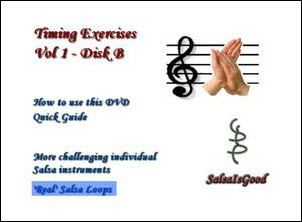 |
|
8) Finally, the cherry on the cake. The final Chapter Real Salsa Loops, from the main Menu as in Figure 9, contains loops taken from different real salsa songs.
Here, not only can you apply your musical understanding to real songs as you may encounter them on the dance floor, but also you may check your progress with the test yourself tracks. See if you find your clapping in synch with the video guide when it comes and goes. This is the ultimate way to check whether salsa rhythm is now in your hands, or even better, unconsciously settled in your brain.
|
| Figure 9 |
|
| |
| 2 DVDs - $40 |
|
|
 |
|
|
|
|
|
|
How to use Timing Exercises Volume 2 |
| This DVD series is organized very differently from other dance DVDs. So it is very important you spend a few minutes reading these instructions carefully to make the most of it.
What is in the DVD? What is in the DVD? This DVD is not for passive entertainment. This DVD is a timing program with exercises for you to do and exams along the way. Doing the exercises involves performing basic salsa footwork in time to the music with different instruments, different speeds and increasing levels of difficulty! You can work your way through the program by selecting each of the different footwork exercises, one by one, and then performing in time with your selection of instrument/song, timing and counting options. You can test your progress by checking your footwork against what you see and hear in the DVD and by selecting the “test yourself” clips when you are ready. At all stages, you need to actively participate to get the most out of the DVDs.
What do I need to know? To use this DVD series you need no knowledge of salsa dancing because you are only performing basic salsa footwork in order to learn how to synchronise it to the music timing. Of course it helps if you are already familiar with the basic salsa steps. If you have never seen them before, you will be able to pick them up quickly by watching the clips. It may also help to have some knowledge of musical timing, some of which is explained in our DVD ‘Salsa on the Spur of the Music’. Knowledge of musical timing will help you to make more sense of some footwork exercises, but it is not necessary in order to perform them. Some people learn better with some theoretical knowledge, if you are one such person, have a look at the DVD ‘Salsa on the Spur of the Music’; if you learn better ‘by doing’ just proceed to the footwork exercises.
How do I use the DVDs? These DVDs are for active learning and take commitment. They include a choice of more than 90 individual clips and each clip is a separate footwork exercise. Each clip loops forever, that is, it repeats continuously without stopping so that you never need to rewind. It is designed this way so that you can do each exercise for as long as you need. When you are happy with your progress and you want to change exercise, press the Menu button on your Remote Control. This will stop the clip and bring you to the DVD menu, where you can choose the next footwork exercise.
How should I proceed through the DVDs? Now, let’s see how the DVD series is organised.
|
Instructions for Disc A (Volume 2) |
Disk A. When you first start Disk A you will see a menu like the one in Figure 1.
1) Select the title Exercises with individual Salsa Instruments, with your remote control and press Play. Once you choose this chapter you will see a menu as in Figure 2. This section contains different examples of the rhythms that salsa instruments play in common salsa. Once again, explanation of the role of these instruments in salsa music can be found in our DVD Salsa on the Spur of the Music. Choose any instrument by highlighting its icon and pressing Play on the remote control. For example, choose the Conga, as in Figure 2.
2) You will see a set of footwork exercises: the exercises allow you to practise basic salsa footwork to the different rhythms played by the conga. Each of the footwork exercises comes at two speeds, slow and fast. Let’s see how it works.
|
|
Figure 1 |
|
 |
|
3) You will find three kinds of clips. The first kind of clip is called Conga 1 – Standard basics. As an example select the title Conga 1 – Standard basics – slow (as in Figure 3) and press Play on the remote control.
A clip will start to play showing a tutor dancing the basic salsa steps (forward and backward) to a common conga rhythm as in Figure 4. Try to follow the tutor and synchronise your basic steps to the rhythm. Notice also the beat counter on the bottom left: it shows all the 8 beats of a typical music phrase, so you can further visualise the relationship between the footwork and the music. Remember, the clip loops forever, that is, it never stops so you can practise your footwork until you are satisfied with your progress.
To stop the clip, press the Menu button on your remote control. |
| Figure 2 |
|
4) As you can see, the basics steps are executed On1 and there is no voice-over counting the music beat. These are both features you can control. By pressing the Angle button on your remote control you can choose which style you want to dance. You have three options: On1, which is currently playing, On2 Modern mambo (or New York style) or On2 Classic Mambo (or Puerto Rican style also called Contratiempo in Cuba). The difference between the basic steps in these styles is explained in our DVD Salsa on the Spur of the Music.
5) By pressing the Audio button on your remote control you can add a voice-over counting the music beat. This can help to synchronise your basic steps to the music. You have five (!) options: no voice over at all, which is currently playing, or a voice over counting beats 1-5, 2-3-6-7, 2-6, or all beats. Which voice-over you choose may depend on whether you dance On1 or On2, but we recommend you familiarise yourself with all of them. |
|
Figure 3 |
|
|
|
6) Let’s now use the kind of clips called All Conga Rhythms. As an example select the title All Conga Rhythms – slow (as in Figure 5) and press Play. A clip will start to play showing a tutor dancing. There are two differences compared to the clip described above. First, you will not hear just one conga rhythm, but 4 of them one after the other. This shows the variety of rhythms this instrument can play in salsa. It is crucial that you are able to recognise the beat and dance to any of these rhythms.
It is also crucial that you are able to keep your basic steps steady when the conga changes rhythm so that you understand the difference between rhythm changes and speed (the speed remains constant in this clip). |
|
| Figure 4 |
|
| |
In order to help train your brain to pay attention to a rhythm change, a visual warning appears on the screen a few beats before the actual rhythm change as in Figure 6. Pay attention to it; and try to train your brain to be receptive to various messages: the music, the counting and the rhythm changes. There is so much richness in music and your dancing will improve when you can tune into it.
|
|
| Figure 5 |
|
 |
|
7) The second difference is that the tutor does not only execute the standard forward and back basic steps, but scrolls through a set of basic footwork, which also includes side basics, back basics, forward basics, cross basics and Suzie Q. As for the rhythm change, a visual warning as in Figure 7 appears on the screen a few beats before the footwork changes so that you are not taken by surprise.
8) Here also you can add a voice over counting the music beat as we explained before. Simply press the Audio button on your remote control to choose which voice-over you wish to use.
9) Similarly, you can choose which style you want to dance (On1, On2 Modern Mambo or On2 Classic Mambo) by pressing the Angle button on your remote control.
|
| Figure 6 |
10) Now you are ready to test if you have learnt to dance in time with the conga. Select the title Test yourself on the Conga Rhythm (as in Figure 8) and press Play. The tutor starts dancing to the sequence of different conga rhythms. Follow him, making use of the beat counter on the bottom left if you need. At a certain point both the tutor and the beat counter disappear; keep on dancing to the music following your internal clock. Once the tutor and the beat counter appear again, check that you are in synch with them. If you consistently find yourself in synch, then you can progress to the next chapter; if not, keep doing the exercises.
11) Once you have mastered the Conga rhythm, try the other salsa instruments: Bongo, Clave, Guiro & Maracas, Cowbell, Cascara, Timbales, Piano and Bass. |
 |
Figure 7 |
Instructions for Disc A (Volume 2) |
|
12) Let’s now go to Disk B. Once you have learnt to dance to each individual instrument you can progress to Disk B. Choose the chapter Salsa Rhythms, as in Figure 9 and you will reach a menu like Figure 10. Here, you can choose among 3 different salsa songs. You can check how to bring your understanding of the salsa rhythm to a full song with basic
instrumentation, including a piano and a bass. You will also find a Rumba Guaguanco rhythm, which is often used as a variation in salsa and timba.
This is a challenging rhythm but since you will encounter it on the dance floor you need to be able to recognise it and adapt your basic ste ps accordingly. |
|
Figure 8 |
|
 |
|
13) As before, you can choose which clip to exercise with and which speed, either slow or fast. Once you chose a clip, remember to use the Audio button on the remote control to choose the voice-over counting, the Angle button to choose the salsa style and the Menu button to stop the clip and return to the previous menu. Also, remember to use the Test yourself clips to check your learning.
14) Now choose the chapter Transitions, as in Figure 11. You will reach a menu like Figure 12. This is a very important one, so let’s see what each clip offers.
|
| Figure 9 |
| |
15) Choose the title Speed change. In these clips a basic salsa rhythm will change speed (slow to fast and back) every few bars of music. Follow the tutor and listen carefully to the music. Learn to recognise the speed change and to adapt your basic steps to the new speed very quickly, ideally within the first bar of music. These changes occur in real salsa music and you need to be able to handle them. Once you are confident with this, test your progress with the Test yourself clip. |
|
Figure 10 |
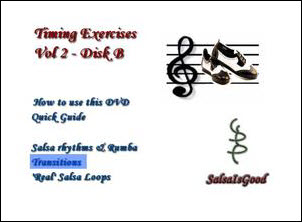 |
|
16) Now choose the title Energy change. Two salsa rhythms with the same speed but with different ‘energy’ (or ‘power’ or ‘intensity’) will alternate every few bars of music. Follow the tutor and listen carefully to the music. The purpose of this clip is to learn to differentiate between the speed of the music, and the energy which it communicates; in salsa these are not always related, as we explain in our DVD Salsa on the Spur of the Music. Learn to recognise the change of energy and intensity in the music while the speed remains the same. These changes occur in almost every salsa song and you need to be able to handle them. Once you are confident with this, test your progress with the Test yourself clip.
|
| Figure 11 |
17) Now choose the title Bongo to Cowbell. You will hear a simple salsa rhythm in the background. On top of this you will notice a louder bongo rhythm; after a while the bongo rhythm stops and is replaced by a cowbell. In many salsa bands the bongo and the cowbell are played by the same musician who alternates between them. He normally plays the bongo early in the song and then switches to the cowbell when the song changes in energy and enters the most powerful session; the cowbell contributes considerably to this increase in energy. Notice that, as before, the speed does not change. The purpose of this clip is to learn to recognise this transition which occurs in many salsa songs and not confuse it with a speed change. Once again, after a while test your progress with the Test yourself clip. |
|
Figure 12 |
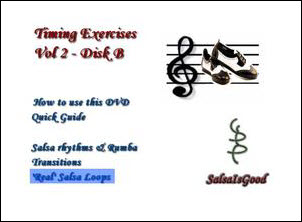 |
|
18) You will find three more titles, On1 to On2 Modern Mambo, On1 to On2 Classic Mambo, and On2 Modern to On2 Classic Mambo. For example, choose On1 to On2 Modern Mambo; you will hear a simple salsa rhythm and the tutor will change his salsa style, that is, he alternates the basic step going from dancing On1 to dancing On2 Modern Mambo. When you dance in a club you will never do this; normally you decide which style to dance and you follow that for the entire song. The purpose of this clip is simply to train your brain to understand the difference in footwork between different styles. This is useful because if you master the transition, then the difference between the styles will be so clear to you that you will be able to dance any style you want without thinking or counting the beat in your head. You will become salsa multi-lingual. Try to master all transitions, including On1 to On2 Classic Mambo, and On2 Modern to On2 Classic Mambo.
|
| Figure 13 |
19) Finally, the cherry on the cake. The final Chapter Real Salsa Loops, from the main Menu as in Figure 13 contains 17 (!!) loops taken from different real salsa songs, as shown in Figure 14 . You will find loops of different salsa styles, from classic salsa to mambo, to timba and son. Here, not only can you apply your musical understanding to real songs as you may encounter them on the dance floor, but also you may check your progress with the Test yourself tracks.. See if you find your footwork in synch with the tutor when it comes and goes. This is the ultimate way to check whether salsa rhythm is now in your hands, or even better, unconsciously settled in your brain. |
|
Figure 14 |
|
| 2 DVDs - $40 |
|
 |
|
 |
|
|
| |
|
|




